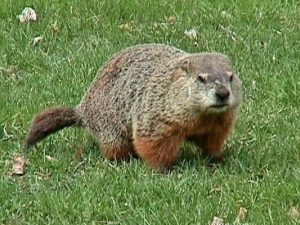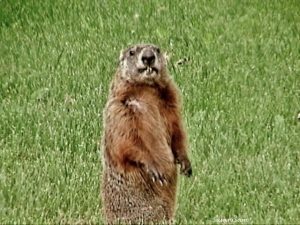Welcome to Woodchuck Wonderland
Home
Welcome to Woodchuck Wonderland

An uncommon and up-close look into the lives of wild groundhogs
Observing groundhogs being groundhogs since 2003!
Read our 2022 scientific research paper, Backyard observations of the behavior and role of the male woodchuck. Have a look at our Woodchuck Food Habits page, videos, and the latest photos. Explore the News and Information page. Check out our Shop, with details on both of our books and ordering photo prints and other items.
WOODCHUCK WONDERLAND CELEBRATES 20 YEARS
To commemorate 20 years of history with this project, we have assembled the following video tribute featuring some of the individual groundhogs we’ve observed over the years. We’ve also updated the latest pictures and review to include years 2021-2023.
THE PROJECT’S BEGINNINGS
In March 2003, a woodchuck appeared in our yard for the first time. We named her Wilhelmina and began photographing her. She gave birth to seven babies, sometimes called chucklings. Eventually, we identified the mate of Wilhelmina and named him Gregory. His teeth were unmistakable!
Our interest grew, and it became clear that photographs were insufficient to capture the activities of these intriguing marmots. So in 2005, we purchased our first camcorder and began videotaping Wilhelmina, her mate Gregory, and their nine babies.
After mother groundhogs bring the chucklings above ground from the nursery, the babies begin to wander away from their natal burrow. We captured the family’s activities, eating, sleeping, playing, climbing trees, and more, by watching, photographing, and videotaping them through our home windows. (Link to YouTube videos) We also observed other mammals, birds, and insects that shared the woodchuck’s territory.
END OF AN ERA AND A NEW BEGINNING

Woodchucks may live about six years in the wild, though the average is about two-three years. They usually breed at two years old. Assuming Wilhelmina was two years old when she arrived in 2003, we estimate she was about ten years old when last seen in 2011. During her life at Woodchuck Wonderland, she had six litters of babies with two of her three mates.
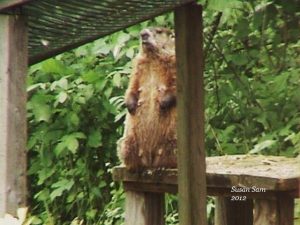
2012 marked a new beginning with a female we named Trudy. She had seven offspring. In 2014 Heidi became our new female resident. In 2015 she and her mate, Luke, were woodchuck parents of seven babies. (see 2015 Photos). In 2016 Heidi had a new mate, Raggedy, and Heidi was mom to eight chucklings! The 2017 season began with five groundhogs, all from 2016, emerging from hibernation. It was an unusual and confusing groundhog season! Check out the 2018, 2020, and 2021-2023 Photos and Review pages to see more real-life Woodchuck Wonderland groundhog stories.
WOODCHUCK NAMES AND IMPORTANCE
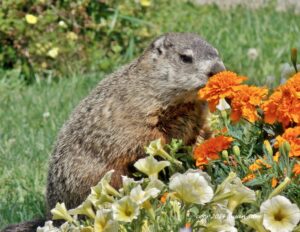
A woodchuck is also called groundhog, whistle pig, wuchak, and Marmota monax. Monax is an American Indian name meaning “the digger.” They are the original of the 15 known marmot species. Groundhogs improve the soil when digging their home by bringing subsoil to the surface and exposing it to weathering action.
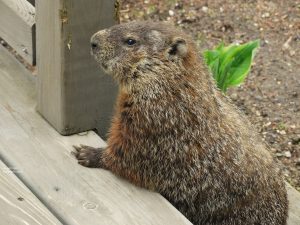
Their burrows are used for hibernating, mating, raising their young, and escaping predators. Besides the nest, the den also has a toilet chamber! Groundhogs don’t leave droppings outside their burrow.
The groundhog is an important food source for foxes, coyotes, hawks, bobcats, etc. While groundhogs hibernate, other animals may use a portion of a groundhog’s den. Animals including red foxes, opossums, rabbits, and skunks use abandoned burrows.
The groundhog is the only animal we have set aside a special day for on our calendar. Groundhogs are essential to medical researchers studying human liver disease, hepatitis B, and liver cancer. Their hibernating abilities are of significant research interest in the space and medical industries.
PROBLEMS COEXISTING?
The two primary complaints about groundhogs are their food needs and digging. So what can be done to minimize these problems?
An adult woodchuck may eat 1 to 1½ pounds of food per day though their food intake decreases as hibernation nears. They survive on their body fat while hibernating and may lose up to ½ of their body weight over winter. So in the spring and early summer, gardens planted near their burrows are especially vulnerable to groundhogs. Repellents such as Epsom salts, rags soaked in cider vinegar, a mixture of water, pepper, garlic, and liquid soap, blood meal, human urine, noise, and electronic motion repellents may discourage problem behavior. The use of fencing, including electrified fences, may also be an effective deterrent. We use pepper, some fencing, and noise as deterrents. Groundhogs prefer hiding places around their burrow holes, so try limiting hiding spots.
If groundhogs dig holes in a problem area, like next to your home foundation, fill in the holes at an appropriate time. We have used a combination of old bricks, larger rocks, dirt, urine, and sometimes used kitty litter to fill in burrow holes in problem areas. Other burrow holes are not disturbed. The Humane Society offers suggestions to prevent groundhogs and other animals from making their homes under sheds and decks.
We hope visitors to this website will better understand and appreciate woodchucks. These suggestions may help with problems encountered in coexisting with them.
DISPELLING MYTHS
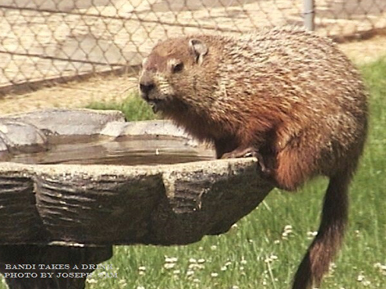
Many myths and stories have circulated about woodchucks. For example, in 1883, the legislature of one state passed a bill authorizing a bounty of 10 cents for every woodchuck killed in the state. In part, they stated, “The Woodchuck is not only a nuisance, but a bore. It burrows beneath the soil and then chuckles to see a mowing machine, man and all, slump into one of these holes and disappear.”
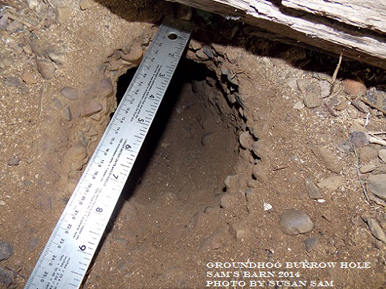
The male woodchuck reportedly has no part in raising or caring for the young. Our observations tell a different story and we are so excited to share these new findings with visitors. Also reported is that woodchucks don’t drink but get their liquids from the juices of plants. We’ve documented them drinking from our birdbath, lapping water in puddles and off plant leaves. Our goal is to sort myth from reality and share what we see about wild groundhogs being groundhogs.
References
https://en.wikipedia.org/wiki/Groundhog
Schoonmaker, WJ, Terres, JK, ed. The World of the Woodchuck, Philadelphia & New York, Living World Books, 1966
